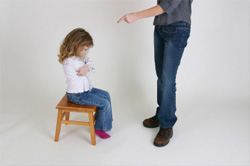
Dr. Glenn Latham, a researcher, professor, and parenting expert says, ""Time-out," a behavior management strategy known to nearly every parent, is one of the most misunderstood and badly used strategies for dealing with the inappropriate behavior of children" (203).
We've been there: trying to manage a time-out can become punishment for you.
Dr. Latham goes on to say, "But when well understood, and well used, it is a wonderful tool for managing children's difficult behaviors" (203).
What are the keys to using time-out effectively?
Teaching versus Time-outs
Time-out should be seen as a time away from reinforcing behaviors, and not a time of punishment. Researchers from BYU (Young et al.) remind parents that good discipline comes down to good teaching (13). When we view time-out as a tool for teaching our children, time-out takes on a different hue than if we look at it as a means to punish.
With misbehavior we should first consider using less formal methods than time-out. Verbal corrections often do the trick, "Sally, Ben was playing with that first so you need to give it back to him. When he's done you can take a turn." And many times we can simply ignore annoying behavior, allowing it to die out on its own.
Warnings?
If we do need to use time-out, Dr. Latham suggests we avoid threatening a child with time-out, using statements like, "If you do that one more time I'll put you in time-out," or, "I'm going to count to three and if you don't stop . . ." because warnings in the moment signal to the child that consequences to their misbehavior are negotiable.
When Do I Use It?
If the behavior cannot be ignored, then utilize time-out. Dr. Latham's suggestion for when time-out is needed includes:
- behaviors that are abusive in any way (verbal or otherwise)
- behaviors that disrupt play to the point that others cannot continue
- behaviors that take over and become the major object of attention, like whining, screaming, and so on (212).
Modeling
In keeping with Young et al.'s recommendation that modeling is part of good teaching, Dr. Latham further suggests, "Both parents and children must have a clear understanding of which behaviors will be treated with time-out [which is why warnings aren't helpful], and the time-out procedure should be rehearsed with children in advance so they know exactly what to expect" (Latham 216).
Role-playing a time-out with your child before you need to use it can make a time-out less frightening for a child, and allows parents to simply administer a time-out without threatening first.
How long should time-out last?
Dr. Glen Latham suggests two to three minutes after a child has calmed down. That means a child could potentially be in time-out for a long time, but that is okay. Checking on the child can actually create a flare-up in behavior, so if you're certain she's safe, leaving her alone is most effective. Sometimes a timer is helpful: You can instruct your child to push the two-minute button when she's calm, and when it goes off she can come out on her own.
What if my child is kicking and screaming, and basically out of control?
In any case of needing to use time-out, Dr. Latham suggests parents "exercise complete self-control: No shouting, screaming, ranting, raving, moralizing, preaching, and so on. Use as few words as possible to get your point across. Try to keep your message to 10 or 12 words: "No, Billy, You may not take the baby's toy" (207). If a child won't move herself to time-out, gently (as you would place a baby in a crib), non-emotionally, take the child underneath her arms and carry her to time-out. If she wanders, continue to quietly, gently set her there, and if that becomes a game, leave the room and close the door behind you.
I want my child to understand how hard this is for me so she'll know to not do it next time.
Actually, we should avoid apologizing or expressing any personal anguish at using time-out to teach the child. "Words like, "I'm sorry I have to do this," or "Please don't make me take you to time-out," aren't as effective as simply saying, "When you behave this way, you may not be with us" (Latham 209). The less emotional we are, the more effective we are at using time-out.
I can't think of a good place in our house to have time-out. What do you suggest?
Time-out should be a place where the child feels safe, but should be devoid of anything enjoyable or entertaining. "It mustn't be dark, frightening, foreboding, cold or hot, dangerous, or cramped. It should just be a bare, stark area" (Latham 210). Dr. Latham even suggests parents create an area that fits this description if needed, whether that means setting off a space with cardboard or hanging sheets over a part of a room. Often time-out areas are not needed for a long time, because a child will quickly learn that good behavior is more rewarding than bad.
What happens afterward?
When the child calmly comes out of time-out skip questions such as, "Are you ready to come out now?" Rather, give her a hug and say, "I'm glad you're ready to play now," and let her be on her way.

Time-out can be a very effective method of teaching our children appropriate behavior. Dr. Glen Latham encourages parents to use time-out "in a precise, therapeutic way" (211).
This echoes the findings of Young et al., who tell parents that the key to good discipline is to view it first and foremost as teaching.
Sources
Latham, Glenn I. The Power of Positive Parenting: A Wonderful Way to Raise Children. Logan, UT: P&T Ink, 1994.
Young, Richard K., Sharon Black, Michelle Marchant, Katherine J. Mitchem, and Richard P. West. "A Teaching Approach to Discipline: An Alternative to Punishment." Marriage & Families, August (2000): 9-15.